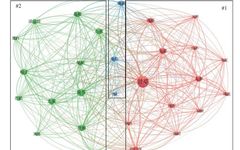This official account is the WeChat of the National Administration of Traditional Chinese Medicine. If you have not followed yet, please click the blue “Chinese Medicine” above to follow.
Recently, the “Shanghai Journal of Traditional Chinese Medicine” published a research result led by Professor Yang Aidong from Shanghai University of Traditional Chinese Medicine titled “Data Mining Study on the Prescription Patterns for Epidemic Disease Treatment in the Tang and Song Dynasties.” This study, based on big data analysis of TCM epidemic treatment during the Tang and Song dynasties, shows that: “Supporting the Right and Expelling the Evil” is the main treatment principle for epidemic diseases.
The study selected three categories of diseases based on the concept of epidemic diseases, namely, seasonal (weather-related), malaria, and cholera, and conducted statistical analysis based on the frequency and efficacy of the medications used. The research focused on representative medical texts from the Tang and Song dynasties, including Wang Tao’s “Secret Essentials of External Medicine,” Sun Simiao’s “Essential Prescriptions Worth a Thousand Gold,” and the “Taiping Shenghui Fang” compiled by Wang Huaiyin and Wang You, as well as the “Taiping Huimin Heji Bureau Fang” compiled during the Song dynasty, emphasizing the study of seasonal (weather-related), malaria, and cholera. Through the comprehensive search platform of CNKI, combined with the use of the Duxiu comprehensive search platform, the Weipu journal resource integration service platform, and the Wanfang data knowledge service platform, the study analyzed the prescriptions and medications for treating epidemic diseases in these medical texts, comparing the similarities and differences in medication and compatibility between ancient and modern times, summarizing the characteristics of prescriptions and medication used for treating epidemic diseases during the Tang and Song dynasties, and gaining insights into the diagnostic and treatment approaches of Tang and Song physicians towards epidemic diseases, providing references for contemporary clinical prescription and research direction choices.
This study found that in the treatment of epidemic diseases during the Tang and Song dynasties, the proportion of exterior-releasing herbs was greater than that of heat-clearing herbs, and the application of heat-clearing herbs and warming herbs was relatively balanced. In the treatment of seasonal (weather-related) diseases, Huang Qin (Scutellaria baicalensis) and Mai Dong (Ophiopogon japonicus) appeared frequently and were closely related, serving to clear heat and dry dampness, expel epidemic toxins, and nourish yin to prevent dryness. In the treatment of malaria, the combination of Chang Shan (Dichroa febrifuga) and Gan Cao (Glycyrrhiza uralensis) was commonly used, with Chang Shan being the most frequently used herb in this disease, paired with Gan Cao to expel evil without harming the right. In cholera treatment, Ren Shen (Panax ginseng) and Gan Cao appeared frequently, focusing on benefiting qi and solidifying the foundation, stimulating the body’s righteous qi to expel evil, reflecting the characteristics of treating epidemics by tonifying.
The results indicate that compared to later generations, the principle of supporting the right was of great importance in the treatment of epidemic diseases during the Tang and Song dynasties, with a relatively balanced use of exterior-releasing, heat-clearing, and warming herbs, among which exterior-releasing herbs were slightly more prevalent. From later generations to the present, the different applications of heat-clearing and warming herbs in various epidemic diseases have already been reflected during the Tang and Song dynasties.
It is reported that this study preliminarily explored the commonly used herbs and their associations in the treatment of epidemic diseases during the Tang and Song dynasties. In subsequent research, it will combine this study with the treatment of acute infectious diseases in contemporary clinical practice, allowing the findings of literature research to better serve clinical needs and provide references for the development of new Chinese medicines and effective treatment pathways.
Source: China Traditional Chinese Medicine News, Reporter: Xu Jing
Below is the full text of the paper:

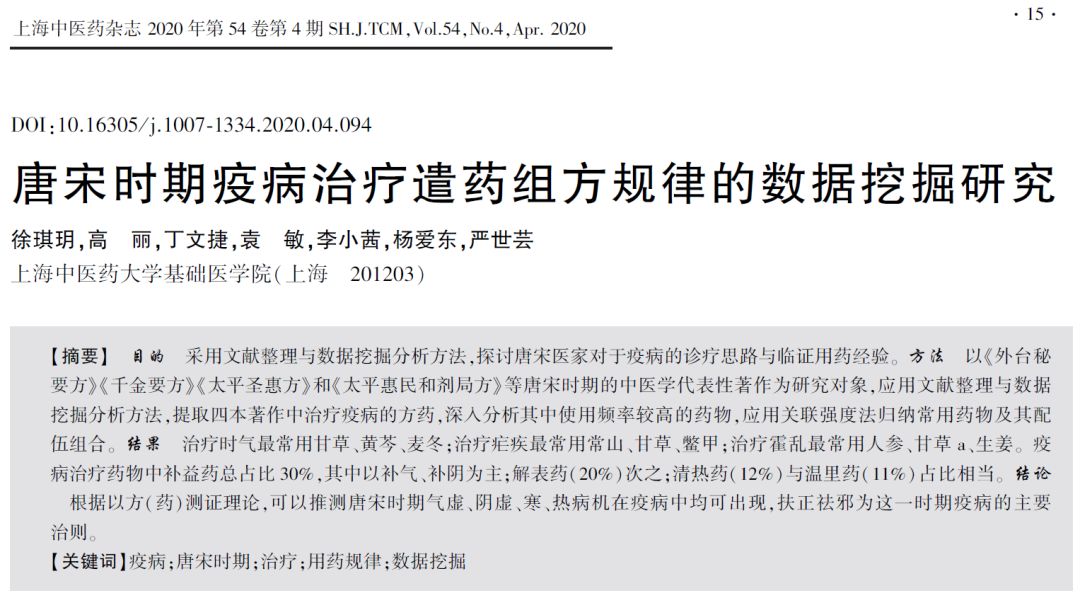
In recent years, factors such as global warming, air pollution, population migration, and excessive work stress have led to a decline in human immune function and an increase in infection opportunities. The resistance of various bacteria, viruses, and other pathogenic microorganisms is continuously increasing, and the rate of updating antibiotics is accelerating. Previously controlled diseases such as tuberculosis, schistosomiasis, plague, and cholera have re-emerged.[1]At the same time, new infectious diseases continue to emerge, such as Severe Acute Respiratory Syndrome (SARS), Ebola hemorrhagic fever, Middle East Respiratory Syndrome, and novel coronavirus pneumonia. In 2018 (from January 1, 2018, to December 31, 2018), a total of 7,770,749 cases of legally reportable infectious diseases were reported nationwide (excluding Hong Kong, Macau, and Taiwan), with 23,377 deaths, a reported incidence rate of 559.41 per 100,000, and a reported mortality rate of 1.68 per 100,000.[2]With the advancement of globalization and close cooperation in international trade, infectious diseases, especially newly emerging infectious diseases, once they occur, will affect the entire world.Traditional Chinese Medicine (TCM) has played an active role in the prevention and treatment of influenza, avian influenza, and SARS in the past, and is currently playing an important role in the treatment of novel coronavirus pneumonia.[3]TCM believes that epidemic diseases are a category of diseases with strong infectivity that can cause epidemics. For thousands of years, the Chinese nation has accumulated rich and valuable experience in the struggle against epidemic diseases. According to historical records, there were 49 documented epidemics during the Tang dynasty and 40 during the Song dynasty.[4-5]The Tang and Song dynasties were the peak periods of TCM development, during which new theories were proposed, and many treatment methods still have reference value today. Works such as “Secret Essentials of External Medicine,” “Essential Prescriptions Worth a Thousand Gold,” and “Taiping Shenghui Fang” are comprehensive masterpieces that record a large number of prescriptions and medications for treating epidemic diseases, profoundly influencing later generations of physicians. In-depth research and analysis of the characteristics and compatibility of epidemic disease medications during this period are of great theoretical and practical significance for better understanding the development patterns of epidemic diseases and guiding contemporary clinical practice.1 Definition of Epidemic Diseases Epidemic diseases have been occurring since the pre-Qin period, and it was believed that they were closely related to abnormal weather.[7]For example, in the “Mozi, Chapter on Mutual Affinity,” it is recorded: “If the heavens bring cold and heat out of season, snow, frost, rain, and dew are not timely, the five grains do not ripen, and livestock do not thrive, then diseases and epidemics will occur.”[8]The term “epidemic” is defined in the “Shuowen Jiezi, Section on Diseases” as: “Epidemic refers to diseases affecting the people, derived from the character for disease, with a phonetic component.”[9]The “Suwen, Chapter on Needling Methods” mentions: “When the five epidemics arrive, they all infect each other, regardless of size, and the symptoms are similar.”[10]This indicates that the evil of epidemic diseases has strong epidemic and infectious properties.In the Jin dynasty, Wang Shuhe classified epidemic diseases into two categories: “cold epidemics” and “warm epidemics,” summarizing the causes of epidemic diseases as “seasonal pathogenic qi” or “seasonal epidemic qi.” Wang Shuhe stated: “All seasonal diseases should be warm in spring but are instead extremely cold, hot in summer but extremely cool, cool in autumn but extremely hot, and cold in winter but extremely warm. This is not the proper qi for the season, hence in a year, the diseases of the young and old are often similar; this is the seasonal pathogenic qi.”[11]During the Tang dynasty, the term “Tianxing” replaced the concepts of epidemic diseases, seasonal diseases, and seasonal epidemic diseases. The famous warm disease physician Wu Youke in the Ming dynasty proposed the theory of epidemic qi and authored the first monograph on epidemic diseases in Chinese medical history, “On Warm Epidemics,” which elucidated: “The disease of warm epidemics is neither wind nor cold, nor heat nor dampness, but rather a different kind of qi in the heavens and earth.”[12]This different qi, unlike the six excesses, is referred to as miscellaneous qi. With the introduction of Western medicine into China, the concept of “acute infectious diseases” emerged. Medical texts from the late Qing and early Republic of China state: “Epidemics are acute infectious diseases.”[13]In summary, epidemic diseases refer to a category of diseases with strong infectivity that can cause epidemics, corresponding to various acute infectious diseases in modern medicine.2 Organization and Study of Epidemic Disease Treatment Prescriptions2.1 Data Sources and Research ObjectivesThis study selected representative medical texts from the Tang and Song dynasties, including Wang Tao’s “Secret Essentials of External Medicine,” Sun Simiao’s “Essential Prescriptions Worth a Thousand Gold,” and the “Taiping Shenghui Fang” compiled by Wang Huaiyin and Wang You, as well as the “Taiping Huimin Heji Bureau Fang” compiled during the Song dynasty, focusing on the study of seasonal (weather-related), malaria, and cholera. Through the comprehensive search platform of CNKI, combined with the use of the Duxiu comprehensive search platform, the Weipu journal resource integration service platform, and the Wanfang data knowledge service platform, the study analyzed the prescriptions and medications for treating epidemic diseases in these medical texts, comparing the similarities and differences in medication and compatibility between ancient and modern times, summarizing the characteristics of prescriptions and medication used for treating epidemic diseases during the Tang and Song dynasties, and gaining insights into the diagnostic and treatment approaches of Tang and Song physicians towards epidemic diseases, providing references for contemporary clinical prescription and research direction choices.2.2 Data Processing and Research Methods2.2.1 Standardization of Herb Names Extracting the prescriptions and specific herbs used in the discussions of epidemic diseases from the texts, and referencing “Chinese Herbal Medicine”[14] to standardize herb names, such as standardizing “Gui Xin” to “Rou Gui” (Cinnamon), “Zhi Zi Ren” to “Zhi Zi” (Gardenia), “Niao Shi” to “Mang Xiao” (Sodium Sulfate), “Chi” to “Dan Dou Chi” (Fermented Soybean), “Chen Sha” to “Zhu Sha” (Cinnabar), “Gua Lou” to “Gua Lou” (Trichosanthes), “Gua Lou Gen” to “Tian Hua Fen” (Trichosanthes Root), “Heng Shan” to “Chang Shan” (Dichroa febrifuga), and “Ji She Xiang” to “Ding Xiang” (Clove), etc.2.2.2 Classification of Herb Names This study primarily used “Chinese Herbal Medicine”[14] as the main basis for classifying the efficacy of Chinese herbs. Some herbs, such as Gao Liang Jiang, Pi Shi, and Hu Gu, were not included in this book, and references from other textbooks[15] were used for summarization.2.2.3 Data Analysis Methods Using Excel to establish basic data tables, while also creating a herb name comparison table, cleaning and standardizing the basic data as needed. Additionally, frequency statistics and data analysis of high-frequency herbs were conducted according to disease types and herb name classifications, applying the “association strength” method (using VOS viewer software) for the analysis of herb associations, where the size of nodes and fonts in the association graph depends on the weight of the node; the larger the weight, the larger the font and node; the lines between nodes indicate the number of times they appeared together, with thicker lines representing more frequent co-occurrences.2.3 Results of Data Analysis2.3.1 Overall Medication Patterns for Seasonal (Weather-Related) Diseases In this study, there were a total of 535 prescriptions for treating this category of epidemic diseases, involving 339 Chinese herbs. We extracted the top 15 most frequently used herbs, totaling 1211 occurrences. From Tables 1 and 2, it can be seen that among the 9 categories of herbs, the frequency of exterior-releasing herbs was the highest, reaching 267 times, accounting for approximately 22.05%; followed by qi-tonifying herbs, reaching 263 times, accounting for approximately 21.72%; and then heat-clearing herbs, reaching 153 times, accounting for approximately 12.63%. The top three herbs used were Gan Cao (Glycyrrhiza uralensis), Huang Qin (Scutellaria baicalensis), and Mai Dong (Ophiopogon japonicus). The overall situation of Chinese herbs used for treating this category of diseases is shown in Figure 1.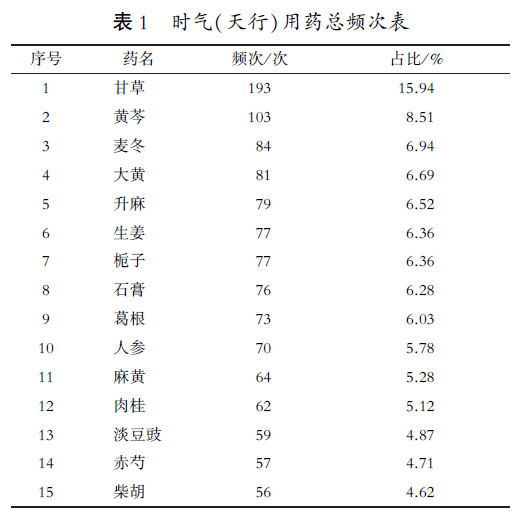
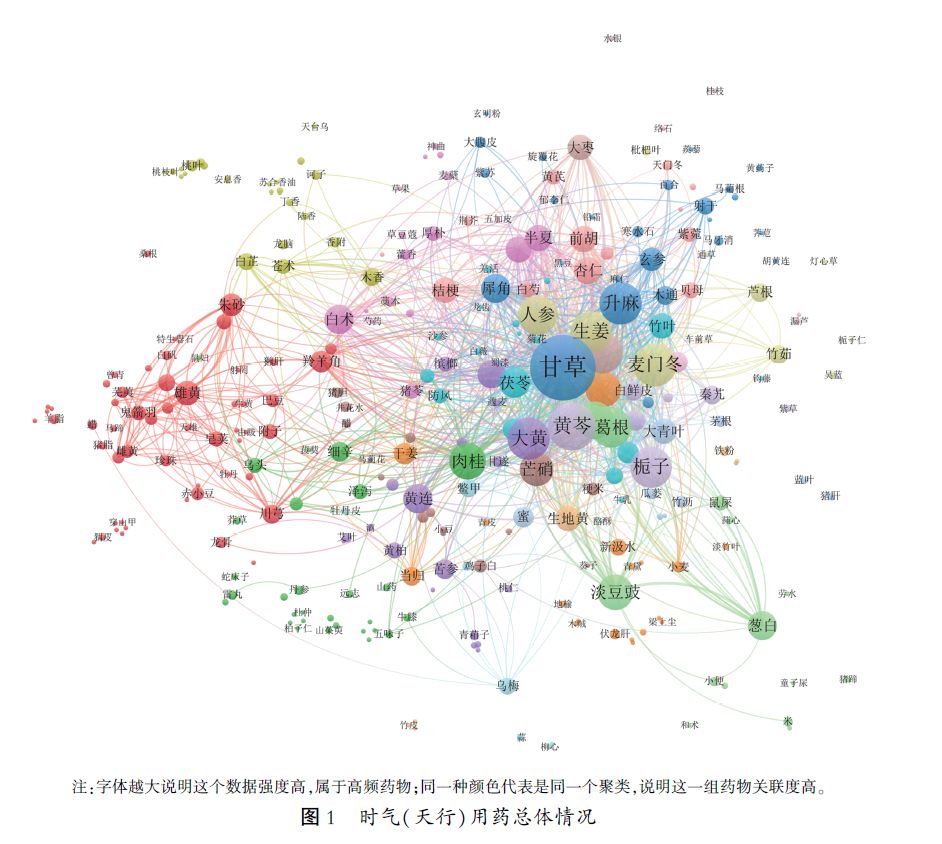
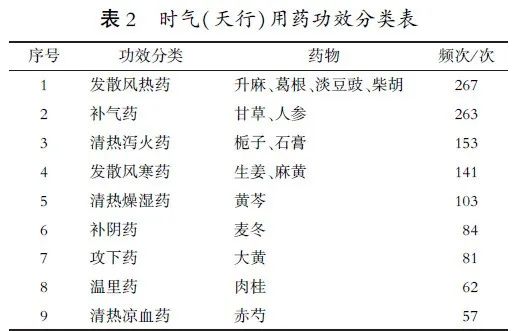 By adjusting the frequency of herb occurrences (frequency > 30 times), Figure 2 was obtained, which included 28 herbs forming 3 clusters. In Figure 2#1, the main herbs are those that support the right: Gan Cao (Glycyrrhiza uralensis), Ren Shen (Panax ginseng), Sheng Jiang (Zingiber officinale), Mai Dong (Ophiopogon japonicus), Rou Gui (Cinnamon), Fu Ling (Poria cocos), Bai Zhu (Atractylodes macrocephala), Da Zao (Ziziphus jujuba), Jie Geng (Platycodon grandiflorum), Zhi Ke (Aurantii Fructus), Qian Hu (Peucedanum praeruptorum), Chen Pi (Citrus reticulata), Ban Xia (Pinellia ternata). In Figure 2#2, the main herbs are heat-clearing herbs: Huang Qin (Scutellaria baicalensis), Da Huang (Rheum palmatum), Sheng Ma (Cimicifuga foetida), Zhi Zi (Gardenia jasminoides), Dan Dou Chi (Fermented Soybean), Ge Gen (Pueraria lobata), Shi Gao (Gypsum), Chai Hu (Bupleurum chinense), Mang Xiao (Sodium Sulfate), Huang Lian (Coptis chinensis), Cong Bai (Allium fistulosum), Xi Jiao (Rhinoceros horn). In Figure 2#3, the main herbs are exterior-releasing herbs: Ma Huang (Ephedra sinica), Chi Shao (Paeonia lactiflora), Xing Ren (Prunus armeniaca). It can be seen that supporting the right, releasing the exterior, and clearing heat are common treatment methods for this category of epidemic diseases.
By adjusting the frequency of herb occurrences (frequency > 30 times), Figure 2 was obtained, which included 28 herbs forming 3 clusters. In Figure 2#1, the main herbs are those that support the right: Gan Cao (Glycyrrhiza uralensis), Ren Shen (Panax ginseng), Sheng Jiang (Zingiber officinale), Mai Dong (Ophiopogon japonicus), Rou Gui (Cinnamon), Fu Ling (Poria cocos), Bai Zhu (Atractylodes macrocephala), Da Zao (Ziziphus jujuba), Jie Geng (Platycodon grandiflorum), Zhi Ke (Aurantii Fructus), Qian Hu (Peucedanum praeruptorum), Chen Pi (Citrus reticulata), Ban Xia (Pinellia ternata). In Figure 2#2, the main herbs are heat-clearing herbs: Huang Qin (Scutellaria baicalensis), Da Huang (Rheum palmatum), Sheng Ma (Cimicifuga foetida), Zhi Zi (Gardenia jasminoides), Dan Dou Chi (Fermented Soybean), Ge Gen (Pueraria lobata), Shi Gao (Gypsum), Chai Hu (Bupleurum chinense), Mang Xiao (Sodium Sulfate), Huang Lian (Coptis chinensis), Cong Bai (Allium fistulosum), Xi Jiao (Rhinoceros horn). In Figure 2#3, the main herbs are exterior-releasing herbs: Ma Huang (Ephedra sinica), Chi Shao (Paeonia lactiflora), Xing Ren (Prunus armeniaca). It can be seen that supporting the right, releasing the exterior, and clearing heat are common treatment methods for this category of epidemic diseases.
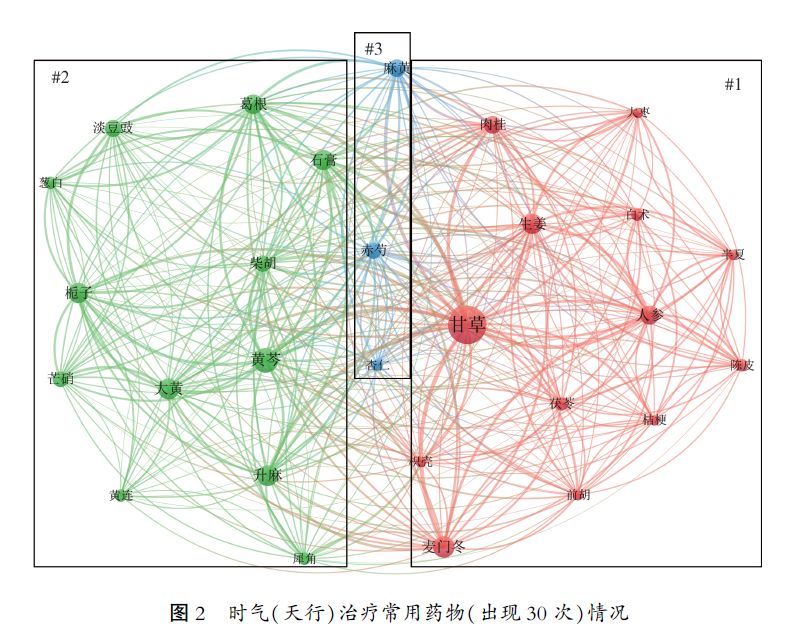
2.3.2 Overall Medication Patterns for Malaria In this study, there were a total of 277 prescriptions for treating this category of epidemic diseases, involving 248 Chinese herbs. We extracted the top 15 most frequently used herbs, totaling 777 occurrences. From Tables 3 and 4, it can be seen that among the 14 categories of herbs, the frequency of vomiting-inducing herbs was the highest, reaching 138 times, accounting for approximately 17.76%; followed by exterior-releasing herbs, reaching 93 times, accounting for approximately 11.97%; and then qi-tonifying herbs, reaching 78 times, accounting for approximately 10.04%. The top three herbs used were Chang Shan (Dichroa febrifuga), Gan Cao (Glycyrrhiza uralensis), and Bie Jia (Trionyx sinensis). The overall situation of Chinese herbs used for treating malaria is shown in Figure 3.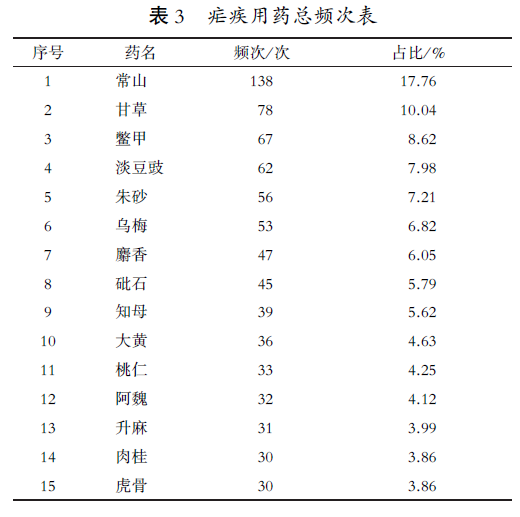
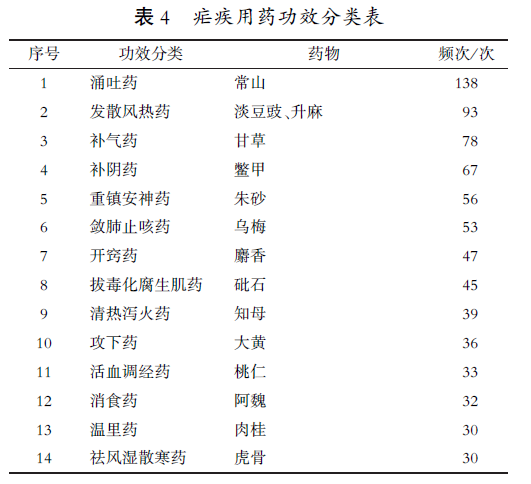
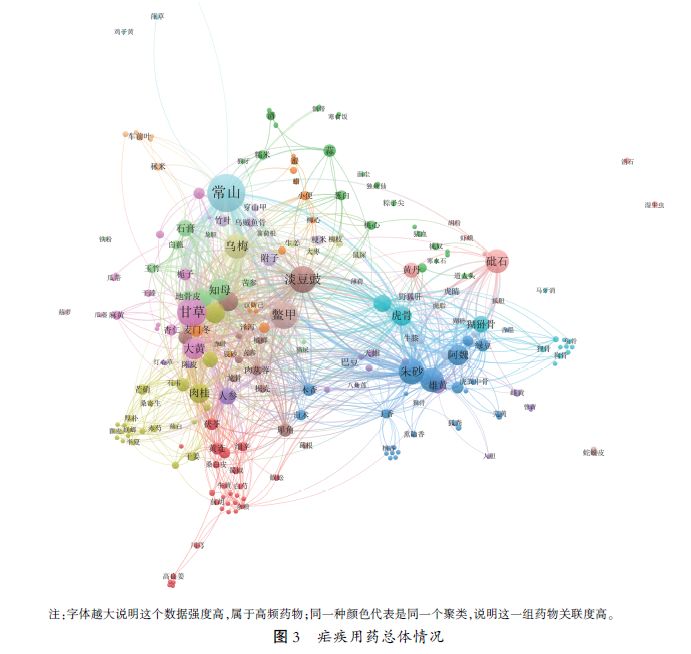 By adjusting the frequency of herb occurrences (frequency > 12 times), Figure 4 was obtained, which included 30 herbs forming 3 clusters. In Figure 4#1, the main herbs are: Zhu Sha (Cinnabar), She Xiang (Musk), Hu Gu (Tiger Bone), Pi Shi (Arsenic), Huang Dan (Realgar), A Wei (Ferula), Xiong Huang (Realgar), Hu Sun Gu (Monkey Bone), Tian Ling Gai (Crown of the Head), Ba Dou (Croton), etc. In Figure 4#2, the main herbs are: Chang Shan (Dichroa febrifuga), Dan Dou Chi (Fermented Soybean), Da Huang (Rheum palmatum), Rou Gui (Cinnamon), Tao Ren (Prunus persica), Fu Zi (Aconitum carmichaelii), Mu Li (Oyster Shell). In Figure 4#3, the main herbs are: Gan Cao (Glycyrrhiza uralensis), Bie Jia (Trionyx sinensis), Wu Mei (Prunus mume), Sheng Ma (Cimicifuga foetida), Zhi Mu (Anemarrhena asphodeloides), Shu Qi (Shuqi), Ren Shen (Panax ginseng), Chai Hu (Bupleurum chinense), Xi Jiao (Rhinoceros horn), Huang Qin (Scutellaria baicalensis), Di Gu Pi (Lycium barbarum), Mai Dong (Ophiopogon japonicus), Shi Gao (Gypsum). It can be seen that tonifying qi, warming the interior, and expelling dampness are common treatment methods for cholera.
By adjusting the frequency of herb occurrences (frequency > 12 times), Figure 4 was obtained, which included 30 herbs forming 3 clusters. In Figure 4#1, the main herbs are: Zhu Sha (Cinnabar), She Xiang (Musk), Hu Gu (Tiger Bone), Pi Shi (Arsenic), Huang Dan (Realgar), A Wei (Ferula), Xiong Huang (Realgar), Hu Sun Gu (Monkey Bone), Tian Ling Gai (Crown of the Head), Ba Dou (Croton), etc. In Figure 4#2, the main herbs are: Chang Shan (Dichroa febrifuga), Dan Dou Chi (Fermented Soybean), Da Huang (Rheum palmatum), Rou Gui (Cinnamon), Tao Ren (Prunus persica), Fu Zi (Aconitum carmichaelii), Mu Li (Oyster Shell). In Figure 4#3, the main herbs are: Gan Cao (Glycyrrhiza uralensis), Bie Jia (Trionyx sinensis), Wu Mei (Prunus mume), Sheng Ma (Cimicifuga foetida), Zhi Mu (Anemarrhena asphodeloides), Shu Qi (Shuqi), Ren Shen (Panax ginseng), Chai Hu (Bupleurum chinense), Xi Jiao (Rhinoceros horn), Huang Qin (Scutellaria baicalensis), Di Gu Pi (Lycium barbarum), Mai Dong (Ophiopogon japonicus), Shi Gao (Gypsum). It can be seen that tonifying qi, warming the interior, and expelling dampness are common treatment methods for cholera.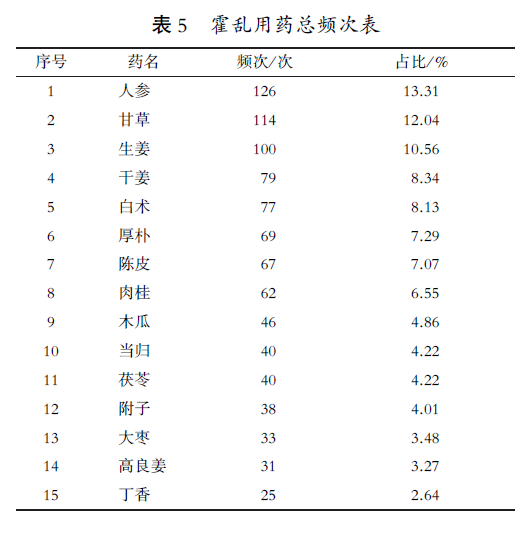
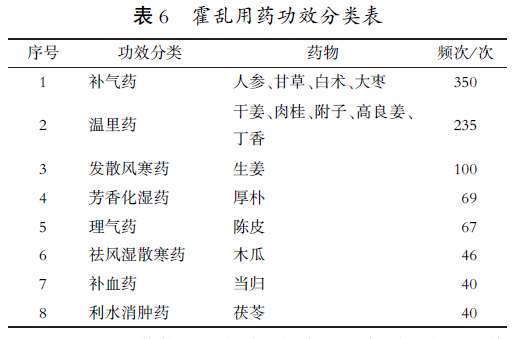
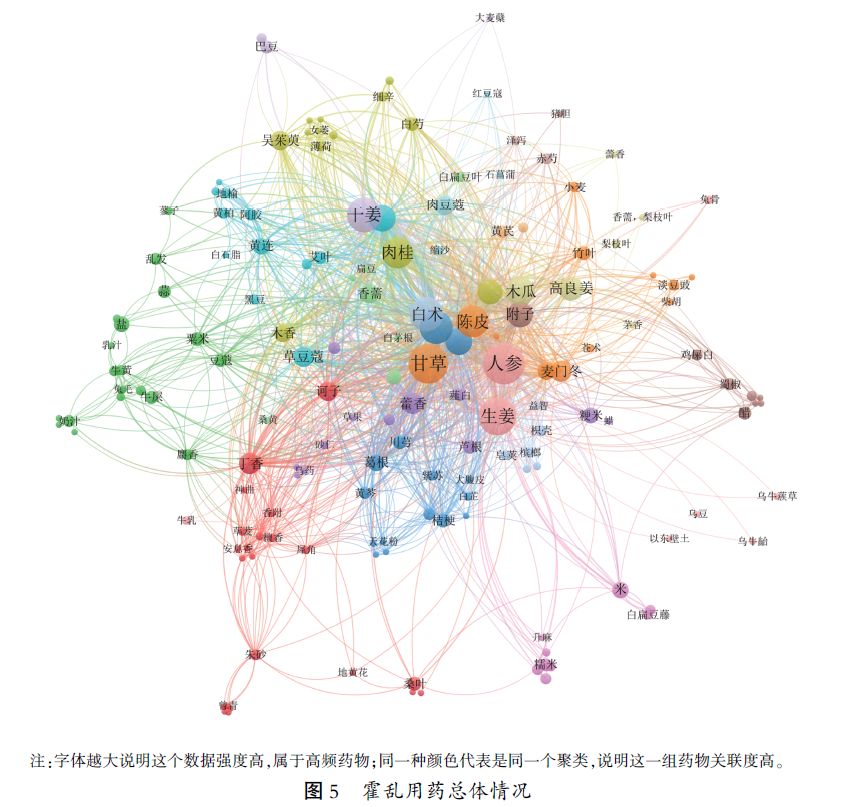 By adjusting the frequency of herb occurrences (frequency > 12 times), Figure 6 was obtained, which included 25 herbs forming 3 clusters. In Figure 6#1, the main herbs are: Ren Shen (Panax ginseng), Sheng Jiang (Zingiber officinale), Hou Po (Magnolia officinalis), Fu Ling (Poria cocos), Mu Guo (Papaya), Mai Dong (Ophiopogon japonicus), Xiang Ru (Elsholtzia stauntonii), Mi (Rice). In Figure 6#2, the main herbs are: Gan Cao (Glycyrrhiza uralensis), Gan Jiang (Dried Ginger), Fu Zi (Aconitum carmichaelii), Ban Xia (Pinellia ternata). In Figure 6#3, the main herbs are: Bai Zhu (Atractylodes macrocephala), Chen Pi (Citrus reticulata), Rou Gui (Cinnamon), Da Zao (Ziziphus jujuba), Dang Gui (Angelica sinensis), Gao Liang Jiang (Alpinia officinarum), Ding Xiang (Clove), He Zi (Terminalia chebula), Rou Dou Kou (Myristica fragrans), Cao Dou Kou (Alpinia katsumadai), Wu Zhu Yu (Evodia rutaecarpa), Mu Xiang (Aucklandia lappa). It can be seen that strengthening the spleen, tonifying qi, and expelling dampness are common treatment methods for cholera.
By adjusting the frequency of herb occurrences (frequency > 12 times), Figure 6 was obtained, which included 25 herbs forming 3 clusters. In Figure 6#1, the main herbs are: Ren Shen (Panax ginseng), Sheng Jiang (Zingiber officinale), Hou Po (Magnolia officinalis), Fu Ling (Poria cocos), Mu Guo (Papaya), Mai Dong (Ophiopogon japonicus), Xiang Ru (Elsholtzia stauntonii), Mi (Rice). In Figure 6#2, the main herbs are: Gan Cao (Glycyrrhiza uralensis), Gan Jiang (Dried Ginger), Fu Zi (Aconitum carmichaelii), Ban Xia (Pinellia ternata). In Figure 6#3, the main herbs are: Bai Zhu (Atractylodes macrocephala), Chen Pi (Citrus reticulata), Rou Gui (Cinnamon), Da Zao (Ziziphus jujuba), Dang Gui (Angelica sinensis), Gao Liang Jiang (Alpinia officinarum), Ding Xiang (Clove), He Zi (Terminalia chebula), Rou Dou Kou (Myristica fragrans), Cao Dou Kou (Alpinia katsumadai), Wu Zhu Yu (Evodia rutaecarpa), Mu Xiang (Aucklandia lappa). It can be seen that strengthening the spleen, tonifying qi, and expelling dampness are common treatment methods for cholera.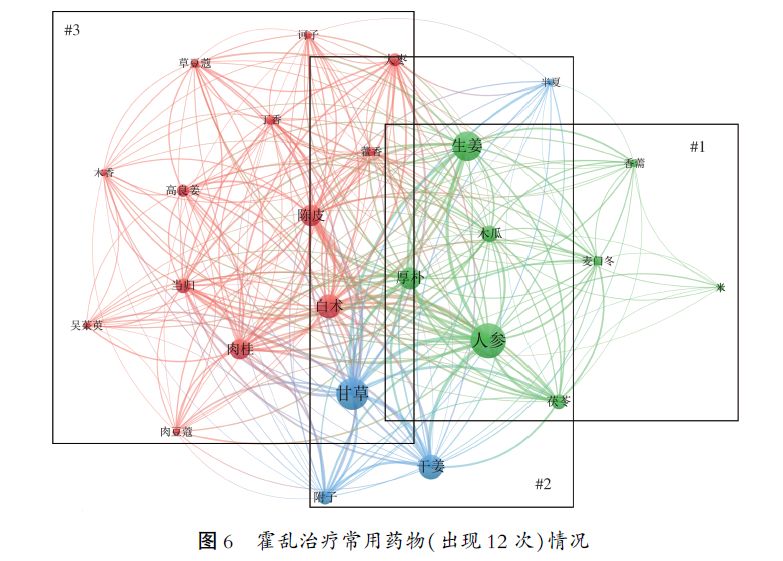 2.4 Analysis of Commonly Used Herbs in Epidemic Disease TreatmentThis study selected three categories of diseases based on the concept of epidemic diseases, namely, seasonal (weather-related), malaria, and cholera, and conducted statistical analysis based on the frequency and efficacy of the medications used. The high-frequency herbs from the above three categories of epidemic diseases were summarized, involving 37 high-frequency herbs, with 16 types of efficacy, totaling 2935 occurrences, as detailed in Figure 7.
2.4 Analysis of Commonly Used Herbs in Epidemic Disease TreatmentThis study selected three categories of diseases based on the concept of epidemic diseases, namely, seasonal (weather-related), malaria, and cholera, and conducted statistical analysis based on the frequency and efficacy of the medications used. The high-frequency herbs from the above three categories of epidemic diseases were summarized, involving 37 high-frequency herbs, with 16 types of efficacy, totaling 2935 occurrences, as detailed in Figure 7.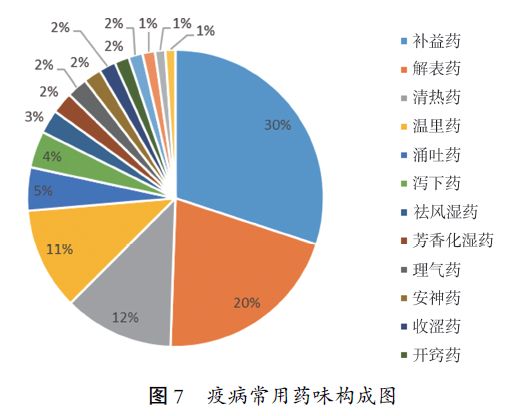 Throughout the commonly used herbs for epidemic diseases during the Tang and Song dynasties, it can be seen that supporting the right and expelling the evil is the main treatment principle for epidemic diseases. In the “Complete Book of Jingyue, Chapter on Epidemics,” it states: “In the case of cold and epidemic diseases, they are both external insults; only those with internal fullness can resist them.”[16]Wang Kentang stated: “Epidemics are the violent qi of the heavens circulating. The method should be to disperse the epidemic qi and primarily support the righteous qi.”[17]Supporting the right includes supporting qi, blood, yin, and yang. In this study, we found that the tonifying herbs used in the treatment of epidemic diseases during the Tang and Song dynasties accounted for more than 30%, with a focus on qi and yin tonification.In addition, expelling evil and stabilizing the right, among the expelling evil herbs, there are also categories such as exterior-releasing, heat-clearing, inducing vomiting, purging, expelling dampness, calming the spirit, astringing, opening orifices, detoxifying, promoting blood circulation, and digesting food, among which exterior-releasing and dispersing evil (20%), heat-clearing and detoxifying (12%), and warming herbs (11%) were frequently seen. The high-frequency herbs mainly included Gan Cao (Glycyrrhiza uralensis), Ren Shen (Panax ginseng), Rou Gui (Cinnamon), Mai Dong (Ophiopogon japonicus), as well as Bai Zhu (Atractylodes macrocephala), Da Zao (Ziziphus jujuba), Gan Jiang (Dried Ginger), Fu Zi (Aconitum carmichaelii), Ding Xiang (Clove), Gao Liang Jiang (Alpinia officinarum), Sheng Ma (Cimicifuga foetida), Ge Gen (Pueraria lobata), Dan Dou Chi (Fermented Soybean), Chai Hu (Bupleurum chinense), Sheng Jiang (Zingiber officinale), Ma Huang (Ephedra sinica), Zhi Zi (Gardenia jasminoides), Shi Gao (Gypsum), Zhi Mu (Anemarrhena asphodeloides), Chang Shan (Dichroa febrifuga), Shu Qi (Shuqi), Bie Jia (Trionyx sinensis), Da Huang (Rheum palmatum), Huang Qin (Scutellaria baicalensis), Hou Po (Magnolia officinalis), Fu Ling (Poria cocos), Hu Gu (Tiger Bone), Mu Guo (Papaya), Zhu Sha (Cinnabar), Wu Mei (Prunus mume), Chi Shao (Paeonia lactiflora), She Xiang (Musk), Dang Gui (Angelica sinensis), Pi Shi (Arsenic), Tao Ren (Prunus persica), A Wei (Ferula), Chen Pi (Citrus reticulata). This indicates that the treatment of epidemic diseases at that time included various methods such as expelling dampness, warming the interior, detoxifying, digesting food, and promoting blood circulation.3 Ancient and Modern Applications and Reflections on Epidemic Disease Treatment PrescriptionsThe Ming and Qing dynasties were periods of mature development in epidemic disease treatment. Given the violent nature of epidemic diseases, strong pathogenicity, rapid onset, and swift changes, specialized prescriptions for clearing and expelling evil were often used to treat epidemics.[18]In contrast, during the Tang and Song dynasties, supporting the right was the primary method for treating epidemics, mainly utilizing qi-tonifying herbs, warming herbs, and yin-tonifying herbs. The top herb, Gan Cao (Glycyrrhiza uralensis), is sweet and neutral, entering the heart, lung, spleen, and stomach meridians, with effects of benefiting qi and tonifying the middle, clearing heat and detoxifying, expelling phlegm and stopping cough, alleviating pain, and harmonizing the properties of other herbs.Modern pharmacological research results indicate[19] that Gan Cao possesses various active effects, including liver protection, anti-inflammatory, antibacterial, antiviral, cough suppression, anti-malarial, antioxidant, anti-cancer, immune regulation, blood sugar reduction, and anti-platelet aggregation. Furthermore, the use of warming herbs in the treatment of epidemic diseases during the Tang and Song dynasties was more common than in later generations, possibly related to the climatic differences of different historical periods. In ancient times, there was a concept of cold epidemics, mainly caused by extreme cold epidemic toxins. Some scholars have linked cold epidemics to the influenza outbreaks in northern regions during the 1990s and the SARS outbreak in 2003.[20]This point is worth noting for contemporary clinical practice, providing insights for modern epidemic disease treatment.It is noteworthy that this study found that in the treatment of epidemic diseases during the Tang and Song dynasties, the proportion of exterior-releasing herbs was greater than that of heat-clearing herbs, and the application of heat-clearing herbs and warming herbs was relatively balanced. The sweating method proposed by Zhang Jingyue in the Ming dynasty was the first among the six methods for treating epidemics, with the other five methods following, indicating that sweating and dispersing evil played a crucial role in the treatment of epidemic diseases. In the Ming and Qing dynasties, the method of expelling evil and releasing the exterior was also highly regarded by many physicians as the primary task in the treatment of warm diseases and epidemics. In contemporary early treatment of epidemic diseases, more and more physicians and scholars are emphasizing the timely application of exterior-releasing herbs. Additionally, although heat-clearing herbs are also widely used in clinical practice during the Ming and Qing dynasties and even today, based on the results of this study, we found that the application of warming herbs was also significant in the treatment of various epidemic diseases during the Tang and Song dynasties, indicating that both cold and heat pathogenic mechanisms can occur in epidemic diseases. Considering the recent large-scale epidemics that have occurred mainly in China, the TCM pathogenic mechanisms for SARS were primarily based on heat toxins, while the novel coronavirus pneumonia was primarily based on damp toxins, with specific associations warranting further research.Based on the results of this study, we conducted corresponding herb association analyses for the three different epidemic diseases, finding that in the treatment of seasonal (weather-related) diseases, Huang Qin (Scutellaria baicalensis) and Mai Dong (Ophiopogon japonicus) appeared frequently and were closely related, serving to clear heat and dry dampness, expel epidemic toxins, and nourish yin to prevent dryness. In the treatment of malaria, the combination of Chang Shan (Dichroa febrifuga) and Gan Cao (Glycyrrhiza uralensis) was commonly used, with Chang Shan being the most frequently used herb in this disease, effective in stopping phlegm and treating malaria, but “if used incorrectly, the true qi will be harmed,” thus paired with Gan Cao to expel evil without harming the right. In cholera treatment, Ren Shen (Panax ginseng) and Gan Cao (Glycyrrhiza uralensis) appeared frequently, focusing on benefiting qi and solidifying the foundation, stimulating the body’s righteous qi to expel evil, reflecting the characteristics of treating epidemics by tonifying. These three herbs all use Gan Cao to harmonize and adjust, expelling evil while protecting the righteous qi. As Zhang Jingyue stated: “The method of harmonizing is to correct what is unharmonious. For diseases with both deficiency and excess, tonify and harmonize; for those with stagnation, move and harmonize; for those with cold, warm and harmonize; for those with heat, cool and harmonize.”[16]It can be seen that the harmonizing method can correct the imbalances of qi, blood, yin, and yang within the body, which is particularly evident in the prescriptions for treating epidemic diseases during the Tang and Song dynasties. Professor Yan Shiyun is adept at using the harmonizing method to treat external heat diseases and miscellaneous diseases. Regarding the current novel coronavirus pneumonia epidemic, he believes that understanding its etiology and pathogenesis from the categories of “epidemic diseases” and “damp pestilence” and emphasizing the use of the “harmonizing method” in diagnosis and treatment can more easily broaden thinking and facilitate treatment.[21-22]In the treatment of the current novel coronavirus pneumonia, we have found that the application of Ren Shen Bai Du San (Ginseng Decoction to Overcome Pathogenic Factors) is quite common.[23]This formula, derived from the “Taiping Huimin Heji Bureau Fang, Treating Cold Damage,” has been promoted by later generations as the first formula for treating epidemics. In addition to releasing the exterior, it also tonifies qi and supports the right with Ren Shen (Panax ginseng) and Gan Cao (Glycyrrhiza uralensis), dispersing qi, blood, dampness, phlegm, and other stagnations. Ren Shen Bai Du San is widely used in the treatment of various epidemic diseases and still holds a place in the treatment of epidemics today, reflecting the comprehensive application of the methods of supporting the right and releasing the exterior.In summary, we believe that compared to later generations, the principle of supporting the right was of great importance in the treatment of epidemic diseases during the Tang and Song dynasties, with a relatively balanced use of exterior-releasing, heat-clearing, and warming herbs, among which exterior-releasing herbs were slightly more prevalent. From later generations to the present, the different applications of heat-clearing and warming herbs in various epidemic diseases have already been reflected during the Tang and Song dynasties.The urgent outbreak of the novel coronavirus pneumonia epidemic, the widespread nature of the disease, and the shortage of effective treatment drugs have posed unprecedented challenges to healthcare workers. TCM has a long history of treating epidemic diseases. How to make ancient classic formulas play a practical guiding role in the real world is the mission of every TCM practitioner. This study has preliminarily explored the commonly used herbs and their associations in the treatment of epidemic diseases during the Tang and Song dynasties. In subsequent research, we will combine this study with the treatment of acute infectious diseases in contemporary clinical practice, allowing the findings of literature research to better serve clinical needs and provide references for the development of new Chinese medicines and effective treatment pathways.References: omitted
Throughout the commonly used herbs for epidemic diseases during the Tang and Song dynasties, it can be seen that supporting the right and expelling the evil is the main treatment principle for epidemic diseases. In the “Complete Book of Jingyue, Chapter on Epidemics,” it states: “In the case of cold and epidemic diseases, they are both external insults; only those with internal fullness can resist them.”[16]Wang Kentang stated: “Epidemics are the violent qi of the heavens circulating. The method should be to disperse the epidemic qi and primarily support the righteous qi.”[17]Supporting the right includes supporting qi, blood, yin, and yang. In this study, we found that the tonifying herbs used in the treatment of epidemic diseases during the Tang and Song dynasties accounted for more than 30%, with a focus on qi and yin tonification.In addition, expelling evil and stabilizing the right, among the expelling evil herbs, there are also categories such as exterior-releasing, heat-clearing, inducing vomiting, purging, expelling dampness, calming the spirit, astringing, opening orifices, detoxifying, promoting blood circulation, and digesting food, among which exterior-releasing and dispersing evil (20%), heat-clearing and detoxifying (12%), and warming herbs (11%) were frequently seen. The high-frequency herbs mainly included Gan Cao (Glycyrrhiza uralensis), Ren Shen (Panax ginseng), Rou Gui (Cinnamon), Mai Dong (Ophiopogon japonicus), as well as Bai Zhu (Atractylodes macrocephala), Da Zao (Ziziphus jujuba), Gan Jiang (Dried Ginger), Fu Zi (Aconitum carmichaelii), Ding Xiang (Clove), Gao Liang Jiang (Alpinia officinarum), Sheng Ma (Cimicifuga foetida), Ge Gen (Pueraria lobata), Dan Dou Chi (Fermented Soybean), Chai Hu (Bupleurum chinense), Sheng Jiang (Zingiber officinale), Ma Huang (Ephedra sinica), Zhi Zi (Gardenia jasminoides), Shi Gao (Gypsum), Zhi Mu (Anemarrhena asphodeloides), Chang Shan (Dichroa febrifuga), Shu Qi (Shuqi), Bie Jia (Trionyx sinensis), Da Huang (Rheum palmatum), Huang Qin (Scutellaria baicalensis), Hou Po (Magnolia officinalis), Fu Ling (Poria cocos), Hu Gu (Tiger Bone), Mu Guo (Papaya), Zhu Sha (Cinnabar), Wu Mei (Prunus mume), Chi Shao (Paeonia lactiflora), She Xiang (Musk), Dang Gui (Angelica sinensis), Pi Shi (Arsenic), Tao Ren (Prunus persica), A Wei (Ferula), Chen Pi (Citrus reticulata). This indicates that the treatment of epidemic diseases at that time included various methods such as expelling dampness, warming the interior, detoxifying, digesting food, and promoting blood circulation.3 Ancient and Modern Applications and Reflections on Epidemic Disease Treatment PrescriptionsThe Ming and Qing dynasties were periods of mature development in epidemic disease treatment. Given the violent nature of epidemic diseases, strong pathogenicity, rapid onset, and swift changes, specialized prescriptions for clearing and expelling evil were often used to treat epidemics.[18]In contrast, during the Tang and Song dynasties, supporting the right was the primary method for treating epidemics, mainly utilizing qi-tonifying herbs, warming herbs, and yin-tonifying herbs. The top herb, Gan Cao (Glycyrrhiza uralensis), is sweet and neutral, entering the heart, lung, spleen, and stomach meridians, with effects of benefiting qi and tonifying the middle, clearing heat and detoxifying, expelling phlegm and stopping cough, alleviating pain, and harmonizing the properties of other herbs.Modern pharmacological research results indicate[19] that Gan Cao possesses various active effects, including liver protection, anti-inflammatory, antibacterial, antiviral, cough suppression, anti-malarial, antioxidant, anti-cancer, immune regulation, blood sugar reduction, and anti-platelet aggregation. Furthermore, the use of warming herbs in the treatment of epidemic diseases during the Tang and Song dynasties was more common than in later generations, possibly related to the climatic differences of different historical periods. In ancient times, there was a concept of cold epidemics, mainly caused by extreme cold epidemic toxins. Some scholars have linked cold epidemics to the influenza outbreaks in northern regions during the 1990s and the SARS outbreak in 2003.[20]This point is worth noting for contemporary clinical practice, providing insights for modern epidemic disease treatment.It is noteworthy that this study found that in the treatment of epidemic diseases during the Tang and Song dynasties, the proportion of exterior-releasing herbs was greater than that of heat-clearing herbs, and the application of heat-clearing herbs and warming herbs was relatively balanced. The sweating method proposed by Zhang Jingyue in the Ming dynasty was the first among the six methods for treating epidemics, with the other five methods following, indicating that sweating and dispersing evil played a crucial role in the treatment of epidemic diseases. In the Ming and Qing dynasties, the method of expelling evil and releasing the exterior was also highly regarded by many physicians as the primary task in the treatment of warm diseases and epidemics. In contemporary early treatment of epidemic diseases, more and more physicians and scholars are emphasizing the timely application of exterior-releasing herbs. Additionally, although heat-clearing herbs are also widely used in clinical practice during the Ming and Qing dynasties and even today, based on the results of this study, we found that the application of warming herbs was also significant in the treatment of various epidemic diseases during the Tang and Song dynasties, indicating that both cold and heat pathogenic mechanisms can occur in epidemic diseases. Considering the recent large-scale epidemics that have occurred mainly in China, the TCM pathogenic mechanisms for SARS were primarily based on heat toxins, while the novel coronavirus pneumonia was primarily based on damp toxins, with specific associations warranting further research.Based on the results of this study, we conducted corresponding herb association analyses for the three different epidemic diseases, finding that in the treatment of seasonal (weather-related) diseases, Huang Qin (Scutellaria baicalensis) and Mai Dong (Ophiopogon japonicus) appeared frequently and were closely related, serving to clear heat and dry dampness, expel epidemic toxins, and nourish yin to prevent dryness. In the treatment of malaria, the combination of Chang Shan (Dichroa febrifuga) and Gan Cao (Glycyrrhiza uralensis) was commonly used, with Chang Shan being the most frequently used herb in this disease, effective in stopping phlegm and treating malaria, but “if used incorrectly, the true qi will be harmed,” thus paired with Gan Cao to expel evil without harming the right. In cholera treatment, Ren Shen (Panax ginseng) and Gan Cao (Glycyrrhiza uralensis) appeared frequently, focusing on benefiting qi and solidifying the foundation, stimulating the body’s righteous qi to expel evil, reflecting the characteristics of treating epidemics by tonifying. These three herbs all use Gan Cao to harmonize and adjust, expelling evil while protecting the righteous qi. As Zhang Jingyue stated: “The method of harmonizing is to correct what is unharmonious. For diseases with both deficiency and excess, tonify and harmonize; for those with stagnation, move and harmonize; for those with cold, warm and harmonize; for those with heat, cool and harmonize.”[16]It can be seen that the harmonizing method can correct the imbalances of qi, blood, yin, and yang within the body, which is particularly evident in the prescriptions for treating epidemic diseases during the Tang and Song dynasties. Professor Yan Shiyun is adept at using the harmonizing method to treat external heat diseases and miscellaneous diseases. Regarding the current novel coronavirus pneumonia epidemic, he believes that understanding its etiology and pathogenesis from the categories of “epidemic diseases” and “damp pestilence” and emphasizing the use of the “harmonizing method” in diagnosis and treatment can more easily broaden thinking and facilitate treatment.[21-22]In the treatment of the current novel coronavirus pneumonia, we have found that the application of Ren Shen Bai Du San (Ginseng Decoction to Overcome Pathogenic Factors) is quite common.[23]This formula, derived from the “Taiping Huimin Heji Bureau Fang, Treating Cold Damage,” has been promoted by later generations as the first formula for treating epidemics. In addition to releasing the exterior, it also tonifies qi and supports the right with Ren Shen (Panax ginseng) and Gan Cao (Glycyrrhiza uralensis), dispersing qi, blood, dampness, phlegm, and other stagnations. Ren Shen Bai Du San is widely used in the treatment of various epidemic diseases and still holds a place in the treatment of epidemics today, reflecting the comprehensive application of the methods of supporting the right and releasing the exterior.In summary, we believe that compared to later generations, the principle of supporting the right was of great importance in the treatment of epidemic diseases during the Tang and Song dynasties, with a relatively balanced use of exterior-releasing, heat-clearing, and warming herbs, among which exterior-releasing herbs were slightly more prevalent. From later generations to the present, the different applications of heat-clearing and warming herbs in various epidemic diseases have already been reflected during the Tang and Song dynasties.The urgent outbreak of the novel coronavirus pneumonia epidemic, the widespread nature of the disease, and the shortage of effective treatment drugs have posed unprecedented challenges to healthcare workers. TCM has a long history of treating epidemic diseases. How to make ancient classic formulas play a practical guiding role in the real world is the mission of every TCM practitioner. This study has preliminarily explored the commonly used herbs and their associations in the treatment of epidemic diseases during the Tang and Song dynasties. In subsequent research, we will combine this study with the treatment of acute infectious diseases in contemporary clinical practice, allowing the findings of literature research to better serve clinical needs and provide references for the development of new Chinese medicines and effective treatment pathways.References: omitted
Source of the paper: “Shanghai Journal of Traditional Chinese Medicine”
Editor: Dong Juntong
China Traditional Chinese Medicine
WeChat ID: satcm01


